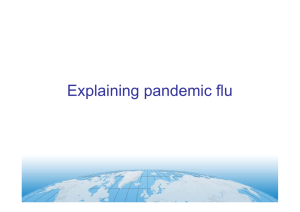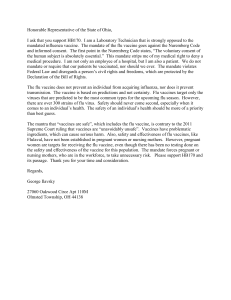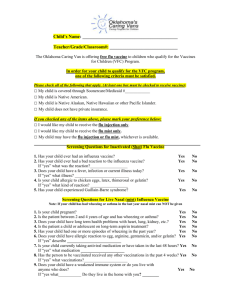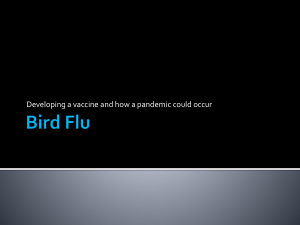Containing pandemic flu
advertisement
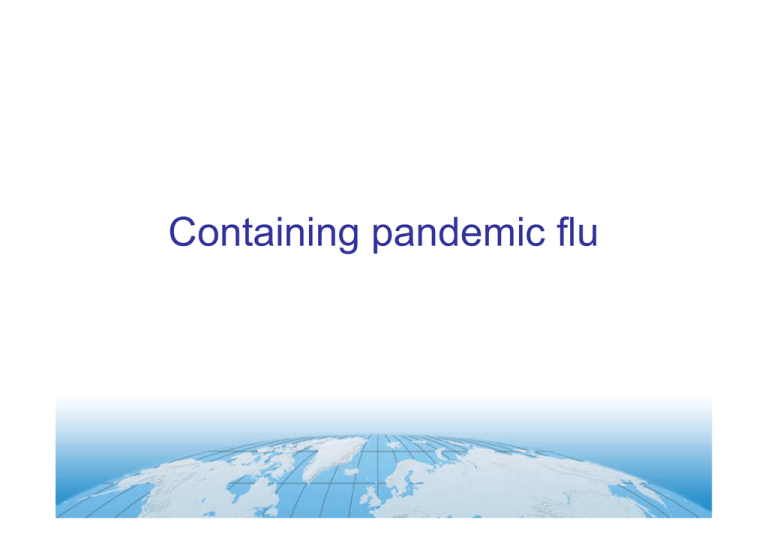
Containing pandemic flu What an influenza pandemic will mean for the UK High levels of illness Intense pressure on health services Disruption to many aspects of daily life Many deaths Reduce impact through: Surveillance Diagnosis Antiviral drugs Vaccines (once they become available) Public health interventions Virological surveillance Year round global activity led by WHO, to: Monitor the evolution of flu viruses Inform recommendations for annual flu vaccine Detect the emergence of new or unusual viruses National and International Surveillance WHO Global Influenza Surveillance network European Influenza Surveillance Network UK: Clinical and virological surveillance co-ordinated by the Health Protection Agency Diagnosis Most often a clinical diagnosis Laboratory tests – molecular detection of virus in clinical specimens – culture of virus – serology Rapid ‘near patient’ tests – detect the presence of flu within 30 minutes – cannot determine the specific virus Public health interventions Personal interventions – Basic measures to reduce the spread of infection • Hand washing: washing hands frequently with soap and water reduces the spread of the virus from the hands to the face, or to others • Respiratory hygiene: covering the mouth and nose when coughing or sneezing; using a tissue when possible; disposing of dirty tissue promptly are carefully – bag and bin • Avoiding non essential travel: non attendance at large gatherings such as concerts, theatres, cinemas, sports arenas etc Possible population-wide interventions Travel restrictions Restrictions of mass public gatherings Schools closure Voluntary home isolation of cases Voluntary quarantine of contacts of known cases Screening of people entering UK ports Antiviral drugs Antiviral drugs Likely to be only major medical countermeasure available early in a pandemic Used in the absence of, or as an adjunct to vaccination Antiviral drugs UK building up a stockpile of 14.6 million courses Stockpile complete September 2006 Reproduced with permission from Roche Products Ltd. Tamiflu ® Antiviral treatment Health workers - as a priority as they will have a higher risk of exposure to the virus Clinical risk groups - those in whom pandemic flu will be more serious General population Who is prioritised will partly depend on the pandemic virus and who it affects the most – for example which groups are particularly vulnerable How do antiviral drugs work? Prevent the flu virus from reproducing Treatment can shorten the illness by a day and reduce hospitalisations by an estimated 50% (based on seasonal flu) To be effective, must be taken within 48 hours of the onset of flu symptoms Treatment Healthcare workers will be prioritised for initial supplies of antivirals Antivirals will be predominantly for treatment of the ill There may be some limited use of antivirals as prophylaxis, if expert advice suggests this appropriate Delivery of treatment NHS will need to ensure: Patients with influenza like illness can access antivirals within 48 hours Patients with severe complications can be appropriately treated in hospital Influenza Vaccine Is there a vaccine? Because the virus will be new, there will be no vaccine ready to protect against pandemic flu A specific vaccine cannot be made until the virus has been identified Cannot be predicted in same way as ‘ordinary’ seasonal flu ‘Ordinary’ flu vaccine or past flu jab will not provide protection Vaccines Routine seasonal flu vaccines will provide little or no protection The new virus strain has to be identified New vaccine must be developed to match the pandemic strain of virus Will have important differences from routine flu vaccine Advance work is being done to facilitate production of a pandemic vaccine once the virus is known Vaccines Four to six months to produce, possibly longer Unlikely to be available during the early stages When available, aim to immunise whole population as soon as possible As production will take time, vaccines will be given to some groups before others according to nationally agreed priorities Vaccine – provisional priority groups Health care workers most at risk Clinical risk groups Institutional settings General population

